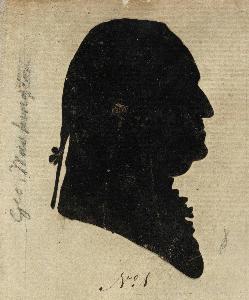William Bache, 1771 - 1845
William Bache, 1771 - 1845;William Bache
- umelec
- Všetky umelecké diela v chronologickom poradí
- Všetky artworks podľa abecedy
- Odporúčané umelecké diela
miesto: Philadelphia
narodený: 1771
smrť: 1845
životopis:
William Bache was a talented American artist who lived from 1771 to 1845. Born in England, he emigrated to Philadelphia in May 1793 with no apparent training as an artist. However, he went on to pursue a successful career as an itinerant artist, producing exquisite miniature portraits in watercolor and silhouettes.
Early Life and Career
Bache was the son of Richard Bache, who served as Postmaster-General of the American Post Office and was the son-in-law of Benjamin Franklin. Despite having no formal training, Bache's natural talent and dedication to his craft enabled him to establish himself as a skilled artist. From 1803 to 1812, he traveled extensively, creating portraits of prominent individuals and families.
Artistic Style and Notable Works
Bache's silhouettes are particularly notable for their accuracy and detail. He is considered one of the most skilled practitioners of the art form in early 19th-century America. His miniature portraits in watercolor are also highly regarded, showcasing his ability to capture the essence of his subjects. Some of Bache's notable works can be found in the collection of the Somerville College in Oxford, UK. The college's art collection includes a range of works by prominent artists, including Roger Eliot Fry, George Romney, and Ivon Hitchens. Bache's contributions to the collection are a testament to his skill and dedication as an artist.
Legacy and Impact
Bache's legacy as an American artist is significant, with his works providing valuable insights into the lives of prominent individuals and families during the early 19th century. His silhouettes and watercolor portraits continue to be admired for their beauty and historical significance. For those interested in learning more about Bache's life and work, the Wikioo.org website provides a range of resources, including biographical information and images of his notable works. The Somerville College collection can also be explored online, offering a glimpse into the college's impressive art collection.
- Notable artists: William Bache, Roger Eliot Fry, George Romney, and Ivon Hitchens
- Museums: Somerville College
- Art movements: Watercolor and silhouettes
The life and work of William Bache serve as a reminder of the importance of preserving our cultural heritage through art. His contributions to American art are a testament to his skill and dedication, and his legacy continues to inspire artists and historians today.


